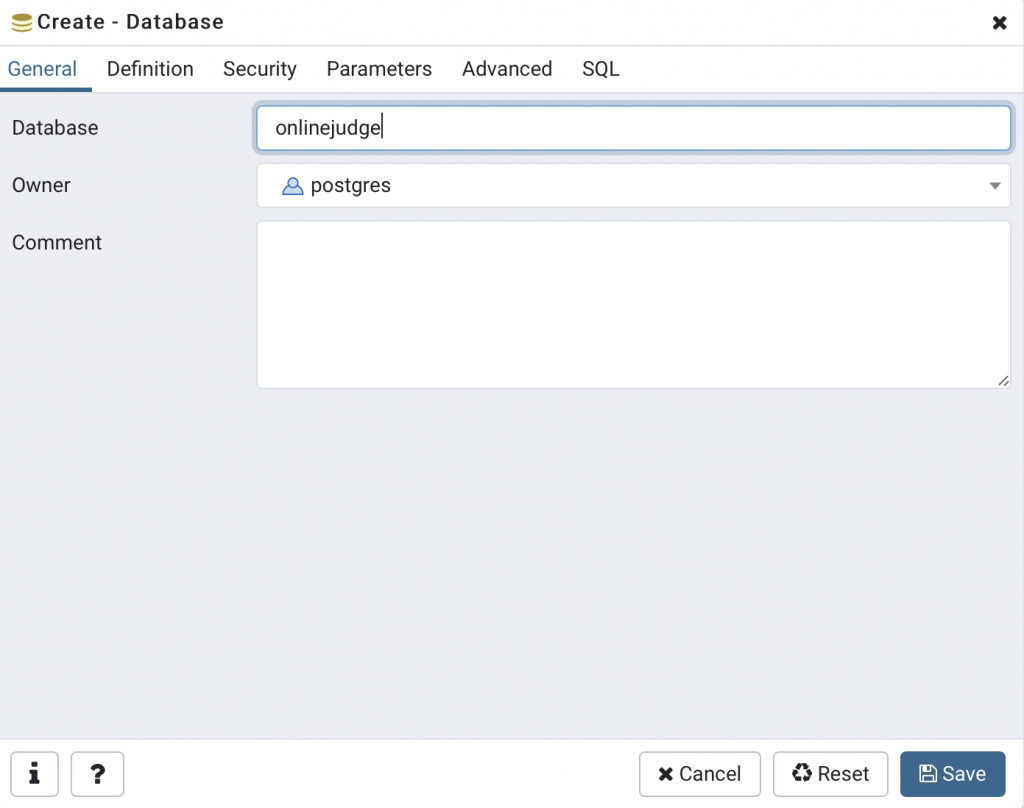
昨天我們架設了 PostgreSQL 資料庫系統,今天就讓我們來讓專案可以將資料儲存進這個資料庫內吧!

關於如何利用 Kotlin 語言去進行 SQL 資料庫的操作,在這裡主要我們會使用 Exposed 這個框架,而為了要使用 Exposed 這個框架,我們會需要下面三個套件:
DataSource(資料來源)物件。因此我們就要先在專案中安裝此三個套件。之前有提過,如果要在專案中安裝套件,我們可以利用 Gradle 來安裝。在 bundle.gradle.kts 的 dependencies 區塊中,增加下面三行以進行套件安裝:
implementation("com.zaxxer:HikariCP:3.4.5")
implementation("org.jetbrains.exposed:exposed:0.17.7")
implementation("org.postgresql:postgresql:42.2.16")
套件安裝好後,先在 pgAdmin 裡面新建一個空的 Database,但這次我們不會直接用圖形介面來創建 Table,而是會直接從程式碼中建立 Table。

創建好一個空的資料庫後,首先先來撰寫資料庫連線用的設定檔,讓我們的專案可以利用這個設定檔丟給 HikariCP 這個套件去跟資料庫連線,底下是位於 resources/hikari.properties 的內容:
dataSourceClassName=org.postgresql.ds.PGSimpleDataSource
dataSource.user=postgres
dataSource.password=<你的密碼>
dataSource.databaseName=onlinejudge
dataSource.portNumber=5432
dataSource.serverName=localhost
解釋一下上面出現的欄位,dataSourceClassName 是要用來創建 DataSource 的類別是哪一個,這裡使用的是來自於 PostgreSQL JDBC Driver 所提供的 org.postgresql.ds.PGSimpleDataSource 類別來進行資料庫的連接與創建 DataSource 物件的方式。
而 dataSource.user 和 dataSource.password 則是登入資料庫所用的帳號與密碼,這裡使用的是超級管理員 postgres 的帳號與密碼。如果你不希望專案握有資料庫太大的權限,可以另外在資料庫內創建一個新 User,讓這個 User 只能操作剛剛建立的 Database。
最後三項 dataSource.databaseName、dataSource.portNumber 和 dataSource.serverName 則分別是 Database 的名稱、資料庫系統監聽的 port 號碼以及資料庫系統所在的位址。由於所在位址是在自己的主機上,所以可以使用 127.0.0.1 或是 localhost 代表自己的主機。
建立好設定檔後,就可以來寫初始化資料庫的函式了。基本上就是利用 HikariCP 讀入此設定檔建立一個 HikariConfig,之後對 HikariConfig 代入你想要操作的 schema 為何,接著利用此設定建立一個 HikariDataSource,再將這個 DataSource 交給 Exposed 去進行資料庫連線即可,整體的程式碼如下:
fun initDatabase() {
val config = HikariConfig("/hikari.properties")
config.schema = "public"
val dataSource = HikariDataSource(config)
Database.connect(dataSource)
}
fun Application.module(testing: Boolean = false) {
initDatabase()
// ...... 後面的程式碼 ......
}
接下來我們要利用程式碼來建立跟昨天一樣的表格,建立的方式是先定義出資料表的結構,再利用 SchemaUtils.create() 去建立這些表格。那首先是 ProblemTable 的程式碼定義,你可以將它與 Problem 的類別寫在一起,以方便管理:
object ProblemTable : Table() {
val id = integer("ProblemId").autoIncrement().primaryKey()
val title = text("Title")
val description = text("Description")
}
這裡出現了我們之前沒看過的語法, object 這個關鍵字是用在如果你要定義的 class 只會生出一個物件的話,你可以直接用 object 簡寫即可,最後宣告出來的結果會類似於其他語言中的 static class 的使用方式,可以直接將該類別當成一個物件來使用。後面 : Table() 即是類別的繼承,讓這個 ProblemTable 繼承 Table 類別,並在創建這個物件時,會呼叫其繼承之類別的建構子。
再來是物件內部的部分,裡面的欄位內容就是定義表格的欄位資料類型,像是 integer() 和 text() 就跟我們之前在 SQL 裡面看到的一樣,是定義該欄位可以存哪種類型的資料,裡面代入的參數即是該欄位在資料庫中的名稱。而如果該欄位有其他的屬性,例如:自動累加或是 Primary Key 的話,則繼續接在後面呼叫即可。
接著來看 TestCaseTable 的程式碼:
object TestCaseTable : Table() {
val id = integer("TestCaseId").autoIncrement().primaryKey()
val input = text("TestInput")
val expectedOutput = text("ExpectedOutput")
val comment = text("Comment")
val score = integer("Score")
val timeOutSeconds = double("TimeOutSeconds")
val problem = integer("ProblemId") references ProblemTable.id
}
基本上跟 ProblemTable 的定義方式類似,只差在 Foreign Key 的部分,使用了 references 這個函式去決定要去參考另外哪個 Table 中的哪個值。關於這個 references,各位可能有觀察到,它在程式碼的寫法上還蠻特殊的,它的呼叫方式居然是介在兩個值之間,這是 Kotlin 的一種叫做 Infix Notation 的函式定義法。底下有個簡單的範例可以讓你稍微了解一下這個 Infix Notation 如何定義以及怎麼使用,而 references 在這裡只是用了相同的方式定義而已。
infix fun Int.add(b: Int) = this + b
// Infix Notation
val c = 30 add 100
// 也可以寫成一般形式
val d = 30.add(100)
那定義完了上面兩個資料表後,就讓我們在 initDatabase() 加入創建這些資料表的步驟吧!
fun initDatabase() {
val config = HikariConfig("/hikari.properties")
config.schema = "public"
val dataSource = HikariDataSource(config)
Database.connect(dataSource)
// 加入這個部分
transaction {
SchemaUtils.create(ProblemTable, TestCaseTable)
}
}
所有對資料庫的操作都必須在 transaction 區塊,每一個 transaction 區塊會保證只有這個區塊的所有動作全部做完,資料庫的內容才會有所變動,如果 transaction 在執行途中出錯,則資料庫會回朔到還沒執行 transaction 區塊內的任何一個指令的狀態。在 transaction 區塊中的 SchemaUtils.create(ProblemTable, TestCaseTable) 則是指要在資料庫內建立起這個兩個表格,如果已經建立過的話,它就會讓這兩個資料表物件與實際資料庫連結起來,你就可以利用這兩個物件直接對資料庫進行操作,就不用去寫 SQL 語法了。
接下來就讓我們來逐步將 RESTful API 的執行內容從操作陣列改換到操作資料庫吧!在更改之前,可以先將我們之前定義的假資料陣列刪除,然後一個一個去思考要怎麼改寫每一個 API 要執行的內容。
首先是取得題目列表資料 GET /problems。利用 ProblemTable 的 selectAll() 函式可將題目都從資料庫拉出來,接著利用 map() 函式一個一個轉成跟我們之前設計時一樣的格式即可。底下是詳細的程式碼,由於一些函式定義上的原因,無法將 call 直接寫在 transaction 區塊內,故會需要一個預先宣告的變數讓結果可從 transaction 區塊中帶出來給 call.respond 函式使用。
get {
var problems: List<Map<String, Any>>? = null
transaction {
problems = ProblemTable.selectAll().map {
mapOf(
"id" to it[ProblemTable.id].toString(),
"title" to it[ProblemTable.title]
)
}
}
call.respond(mapOf(
"data" to problems
))
}
接下來是新增題目資料 POST /problems,由於我們已經將生 id 的職責交給了資料庫,所以在新的版本設計中,我們不希望使用者在發 HTTP request 時會帶 id 過來,但是這又跟原本的 Problem 類別設計不同,那該怎麼辦呢?其實很簡單,那就再定義一個類別即可,這種為了資料傳輸而生的類別物件通常我們稱之為 DTO(Data Transfer Object),所以我們就來設計 Problem 與 TestCase 給 POST 方法使用的 DTO 吧!
// Problem.kt
data class ProblemPostDTO(
val title: String,
val description: String,
val testCases: List<TestCasePostDTO>
)
// TestCase.kt
data class TestCasePostDTO(
val input: String,
val expectedOutput: String,
val comment: String,
val score: Int,
val timeOutSeconds: Double
)
定義完以後,就來利用這個 DTO 撰寫 POST /problems 的內容吧!底下是詳細的程式碼,基本上就是從客戶端手中拿到 ProblemPostDTO 後,利用 ProblemTable.insert() 將新的 Problem 輸入進資料庫,後頭可使用 get 去得到新加的這筆資料的欄位的值,我們利用這個函式拿到資料庫新增的 id,並存到 newProblemId 的變數中,接著再一筆一筆地將 TestCase 加進去 TestCaseTable 之中,並將 Foreign Key problemId 填入剛剛得知的新題目的 id 值即可,最後回傳回這筆新題目的 id 讓客戶端可以知道它剛加的題目 id 為何。
post {
val newProblem = call.receive<ProblemPostDTO>()
var newProblemId : Int? = null
transaction {
newProblemId = ProblemTable.insert {
it[title] = newProblem.title
it[description] = newProblem.description
} get ProblemTable.id
for (testCase in newProblem.testCases) {
TestCaseTable.insert {
it[input] = testCase.input
it[expectedOutput] = testCase.expectedOutput
it[comment] = testCase.comment
it[score] = testCase.score
it[timeOutSeconds] = testCase.timeOutSeconds
it[problemId] = newProblemId!!
}
}
}
call.respond(mapOf(
"problem_id" to newProblemId
))
}
接下來是取得題目詳細資料 GET /problems/{id},基本上就是利用 id 當作條件,從 ProblemTable 和 TestCaseTable 拉出相對應的資料結合起來即可,比較的部分利用在 select 的區塊撰寫條件,做法是利用 欄位.條件(值),這個相等的條件切記不可以使用 ==,原因是這個部分是要建立出相等判斷的 SQL 語法,而不是讓我們直接在 Kotlin 裡面進行判斷,要小心。另外,原先我們設計的 TestCase 是沒有 id 的,但現在為了修改方便,我們會帶上 TestCase 的 id 給使用者,以利之後的修改,底下是詳細的程式碼:
get {
val requestId = call.parameters["id"]?.toInt() ?:
throw BadRequestException("The type of Id is wrong.")
var responseData: Problem? = null
transaction {
val requestProblem = ProblemTable.select {
ProblemTable.id.eq(requestId)
}.first()
val requestTestCases = TestCaseTable.select {
TestCaseTable.problemId.eq(requestId)
}.map {
TestCase(
id = it[TestCaseTable.id].toString(),
input = it[TestCaseTable.input],
expectedOutput = it[TestCaseTable.expectedOutput],
comment = it[TestCaseTable.comment],
score = it[TestCaseTable.score],
timeOutSeconds = it[TestCaseTable.timeOutSeconds]
)
}.toList()
responseData = Problem(
id = requestProblem[ProblemTable.id].toString(),
title = requestProblem[ProblemTable.title],
description = requestProblem[ProblemTable.description],
testCases = requestTestCases
)
}
call.respond(mapOf("data" to responseData))
}
接著是修改資料 PUT /problems/{id} 的部分,這個部分會利用 id 去使用 ProblemTable.update 進行題目方面的修正,而對於一筆一筆的測資,則也是利用其測資的 id 去進行修正,但在這個修正會出現三種情況,分別利用三種不同的操作來對付:
id 不存在於目前給予的測資列表中的那些資料。id,用 null 表示。id。那為了要讓 TestCase.id 可以為 null,這裡又定義了 ProblemPutDTO 與 TestCasePutDTO 兩個類別讓客戶端使用。
// Problem.kt
data class ProblemPutDTO(
val id: String,
val title: String,
val description: String,
val testCases: List<TestCasePutDTO>
)
// TestCase.kt
data class TestCasePutDTO(
val id: String?,
val input: String,
val expectedOutput: String,
val comment: String,
val score: Int,
val timeOutSeconds: Double
)
最後可以得到程式碼如下:
put {
val requestId = call.parameters["id"]?.toInt() ?:
throw BadRequestException("The type of Id is wrong.")
val updateProblemContent = call.receive<ProblemPutDTO>()
transaction {
ProblemTable.update({ ProblemTable.id.eq(requestId)}) {
it[ProblemTable.title] = updateProblemContent.title
it[ProblemTable.description] = updateProblemContent.description
}
TestCaseTable.deleteWhere {
TestCaseTable.problemId.eq(requestId)
.and(TestCaseTable.id.notInList(
updateProblemContent.testCases
.mapNotNull { it.id?.toInt() }
))
}
for (testcase in updateProblemContent.testCases) {
if (testcase.id == null) {
TestCaseTable.insert {
it[TestCaseTable.input] = testcase.input
it[TestCaseTable.expectedOutput] = testcase.expectedOutput
it[TestCaseTable.comment] = testcase.comment
it[TestCaseTable.score] = testcase.score
it[TestCaseTable.timeOutSeconds] = testcase.timeOutSeconds
it[TestCaseTable.problemId] = requestId
}
continue
}
TestCaseTable.update({ TestCaseTable.id.eq(testcase.id.toInt()) }){
it[TestCaseTable.input] = testcase.input
it[TestCaseTable.expectedOutput] = testcase.expectedOutput
it[TestCaseTable.comment] = testcase.comment
it[TestCaseTable.score] = testcase.score
it[TestCaseTable.timeOutSeconds] = testcase.timeOutSeconds
}
}
}
call.respond(mapOf(
"OK" to true
))
}
最後是刪除題目 DELETE /problems/{id} ,這個部分即是利用 ProblemTable.deleteWhere 和 TestCaseTable.deleteWhere 進行刪除即可。但要注意的是, ProblemTable.id 會被 TestCaseTable.problemId 這個 Foreign Key 給侷限住,所以你必須先將侷限住 ProblemTable 資料的 TestCaseTable 內的資料先刪除掉,才能刪除掉 ProblemTable 相對應的題目資料,要小心這個順序。
delete {
val requestId = call.parameters["id"]?.toInt() ?:
throw BadRequestException("The type of Id is wrong.")
transaction {
TestCaseTable.deleteWhere { TestCaseTable.problemId.eq(requestId) }
ProblemTable.deleteWhere { ProblemTable.id.eq(requestId) }
}
call.respond(mapOf(
"OK" to true
))
}
接著就可以來測試看看了,首先先增加一道題目:(這裡我用程式碼的方式簡寫,各位可以將各個部分分別填入 Postman 相對應的欄位中。)
POST http://0.0.0.0:8080/problems
Content-Type: application/json
{
"title": "A + B Problem",
"description": "輸入兩數,將兩數加總。",
"testCases": [
{
"input": "4 5",
"expectedOutput": "9",
"comment": "",
"score": 50,
"timeOutSeconds": 10.0
},
{
"input": "2147483646 1",
"expectedOutput": "2147483647",
"comment": "",
"score": 50,
"timeOutSeconds": 10.0
}
]
}
得到新增的題目編號為 1:
{
"problem_id": 1
}
接著看看題目列表:
GET http://0.0.0.0:8080/problems
會看到剛剛新增的題目:
{
"data": [
{
"id": "1",
"title": "A + B Problem"
}
]
}
接著看看詳細的題目資料:
GET http://0.0.0.0:8080/problems/1
得到題目的詳細資料,也可以看到測資的 id:
{
"data": {
"id": "1",
"title": "A + B Problem",
"description": "輸入兩數,將兩數加總。",
"testCases": [
{
"id": "1",
"input": "4 5",
"expectedOutput": "9",
"comment": "",
"score": 50,
"timeOutSeconds": 10.0
},
{
"id": "2",
"input": "2147483646 1",
"expectedOutput": "2147483647",
"comment": "",
"score": 50,
"timeOutSeconds": 10.0
}
]
}
}
利用得到的詳細資料去修改看看這筆題目資料,這裡更改了題目敘述、增加一筆測資、修改一筆測資並且刪除了一筆測資:
PUT http://0.0.0.0:8080/problems/1
Content-Type: application/json
{
"id": "1",
"title": "A + B Problem",
"description": "輸入兩個數字,將兩個數字加總。",
"testCases": [
{
"id": "1",
"input": "4 0",
"expectedOutput": "4",
"comment": "",
"score": 50,
"timeOutSeconds": 10.0
},
{
"input": "1 5",
"expectedOutput": "6",
"comment": "",
"score": 50,
"timeOutSeconds": 10.0
}
]
}
可以得到修正成功的結果:
{
"OK": true
}
可以再利用 GET http://0.0.0.0:8080/problems/1 檢查一下是否有修改題目資料:
{
"data": {
"id": "1",
"title": "A + B Problem",
"description": "輸入兩個數字,將兩個數字加總。",
"testCases": [
{
"id": "1",
"input": "4 0",
"expectedOutput": "4",
"comment": "",
"score": 50,
"timeOutSeconds": 10.0
},
{
"id": "3",
"input": "1 5",
"expectedOutput": "6",
"comment": "",
"score": 50,
"timeOutSeconds": 10.0
}
]
}
}
最後就將該題目資料刪除吧!
DELETE http://0.0.0.0:8080/problems/1
得到操作成功的結果:
{
"OK": true
}
再利用 GET http://0.0.0.0:8080/problems 取得題目列表看看是否成功刪除了吧!
{
"data": []
}
在今天我們終於將資料管理系統與資料庫連接了,而且也讓我們的 RESTful API 能夠正常運作了。但不知道各位有沒有發現一件奇怪的事情,我們好像都不用認證 HTTP request 的身份,就讓題目可以被新增、可以被修改、可以被刪除,理論上應該只有具有管理員權限的人才能進行這些操作才對呀!所以明天我們就要來看看,該怎麼認證一個 HTTP request 的身份,並阻擋沒有正確身份的人去做修改資料庫的事情。

TestCases Table裡的val problem
應該要改成val problemId
才能跟POST /problems裡的變數名稱對起來?